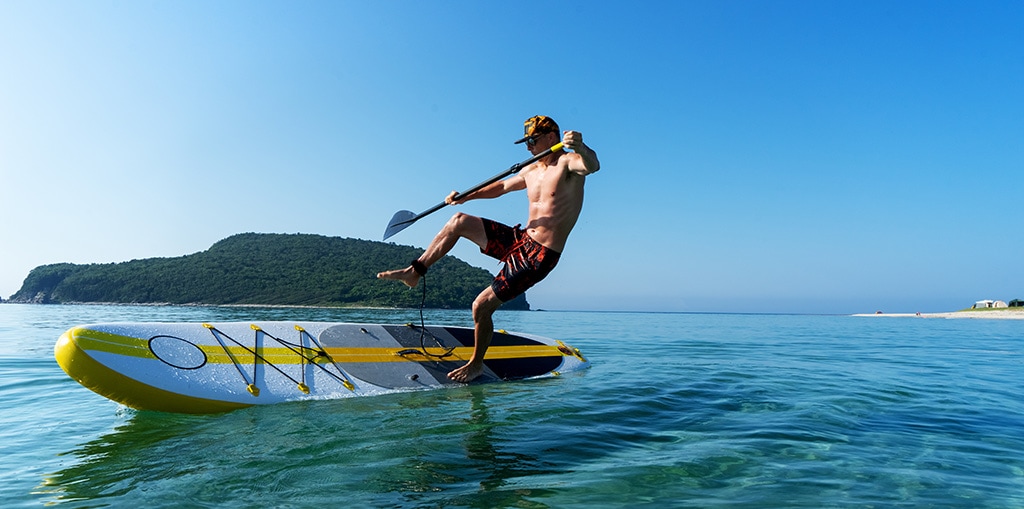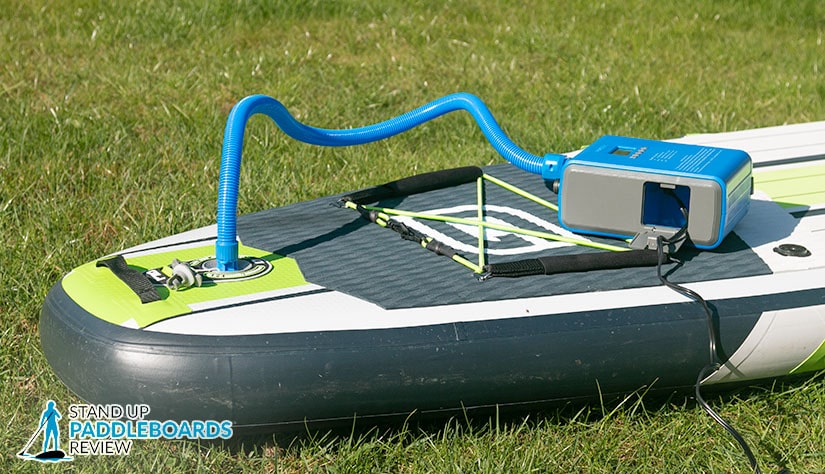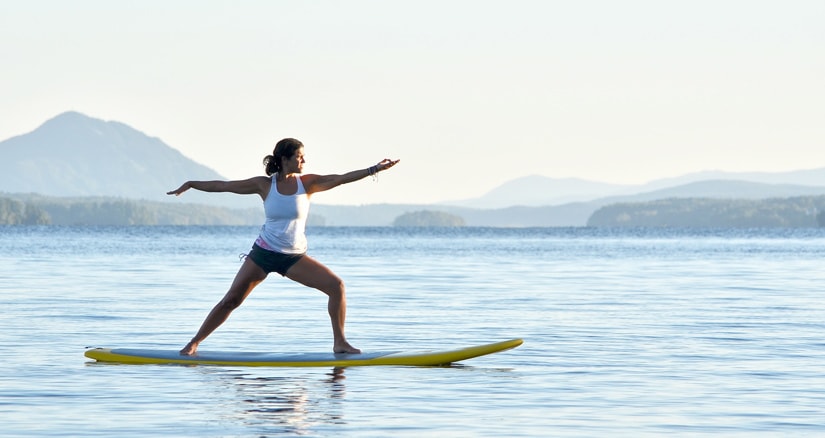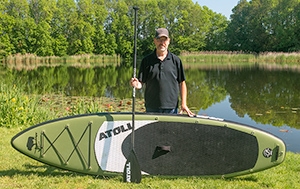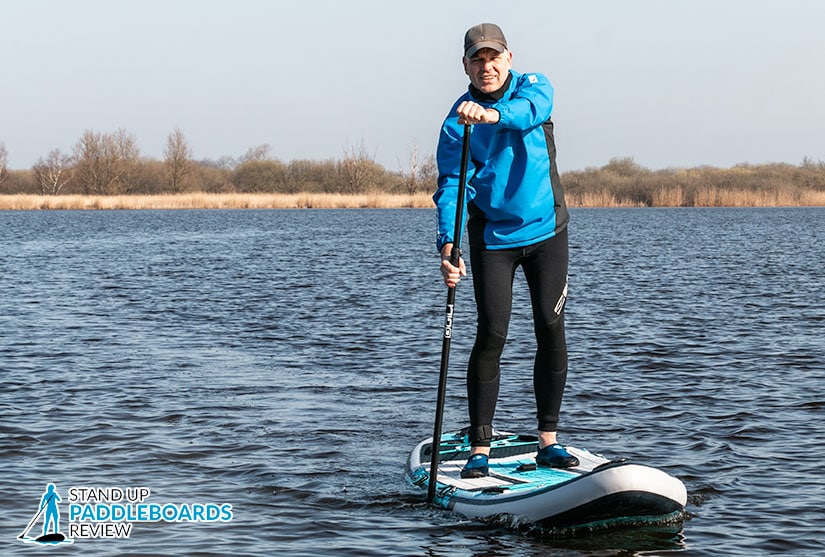A wobbly paddle board is a concern for many first time paddlers.
If you notice that your paddle board is wobbly, there are a couple of things that could be going on. Either there is an issue with your paddle board, or there’s an issue with the way you’re using it.
Today, I’ll explain different factors that might be impacting the stability of your paddle board. Ask yourself some of these key questions, and take the following into consideration if you want to figure out why your paddle board is wobbly.
Is Your Inflatable SUP Board Properly Inflated?
Improper inflation is usually the culprit for a wobbly board. Imagine partially inflating an inflatable mattress or pool floatie. When there’s not enough pressure inside the inflatable to push against outside pressure, you’ll sink into it.
This same occurs with an inflatable stand up paddle board. Even though the paddle board is made out of a durable material, if you underinflate it, there won’t be enough internal pressure pushing back against you as you stand on it.
The results? You’ll have a super wobbly board that is unstable.
Every time you go out with an inflatable paddle board, be sure to inflate it properly. By using an air pump with a PSI gauge. This will allow you to accurately measure the air pressure inside your paddle board.
If you know you’re inflating your board properly, but notice over time that it begins to wobble or gives less push back, it might be more than an inflation issue. Carefully check the outer layer of your inflatable board to make sure you don’t have any pinholes that are allowing air to leak out.
While it’s really difficult to puncture an iSUP, a small pinhole leak could be the culprit. Click here to learn more about how to spot a leak in your inflatable.
Pick the Right SUP Board for Your Water Activities
Not using the right SUP for the type of activity you are doing could be another reason why your board feels wobbly . Whether it’s a yoga paddle board, an all-around SUP, or a touring paddle board, different types of SUPs will offer different features.
If you try to use a paddle board meant for touring as a yoga board, then you will be dealing with a very wobbly board as you stretch.
Yoga Board vs. Touring Board
A general purpose ‘all around’ board and yoga paddle board are designed with stability in mind. Unlike other recreational activities on the water, basic paddling and SUP yoga requires a very stable surface.
Touring SUPs, on the other hand, are designed to maneuver quickly and sharply. Because of this, they are narrower and offer less stability, especially to the inexperienced paddler.
Yoga paddle boards tend to feature a consistent thickness and are wider which increases stability. Touring and rec SUPs on the other hand incorporate features such as tapered edges and narrow noses and tails for more agility on the water and a slimmer construction for more speed.
Inflatable Paddle Board vs. Hardshell Paddle Board
It’s not so much the materials a SUP is made out of but rather how a SUP is designed. Inflatable paddle boards have a much wider base than hard shell paddle boards. Because of this, inflatable paddle boards tend to be a bit more stable. That’s a major reason why they’re the commonly used option for activities like stand up paddleboard yoga.
Find the Right Paddle Board for Your Weight
Your weight can also contribute to the stability as you paddle. Every board has a designated weight capacity which indicates how much combined weight the board can carry before its performance is impacted.
If your board has a weight capacity of 200 pounds, but you weigh 180 pounds, you teeter right on the edge of that weight capacity. Bringing on extra gear or personal belongings could tip you over the 200 pound threshold. If this happens, you’ll notice that your board will become less stable and more wobbly as it struggles to support you.
Better Quality Means Better Performance
It goes without saying that a better quality board will offer more stability than your run-of-the-mill paddle board. When it comes to inflatable SUPs, they can often perform just as well if not better than their hard shell counterparts.
For many people, it makes more sense to opt for a quality inflatable paddle board than a basic hardshell. When you’re looking for a well constructed inflatable stand up paddle board, there are a couple of key features you should look for regardless what type of inflatable SUP you want. These features include the following:
Quality Drop Stitch Technology – Small fibers connect the top of the board to the bottom of the board. This allows you to inflate it to a higher PSI, as it keeps the board’s shape. Without drop stitch, the board would bulge in the middle when inflated to a high PSI..
Optimum PSI Levels – PSI Levels ranging anywhere from 10 to 20 PSI are the way to go when it comes to inflatables. Greater PSI means greater rigidity, durability, and overall performance.
Durable Outer Layer – Along with the drop stitch technology, a quality built inflatable stand up paddle board will have an outer layer made out of a durable rubber and PVC. If you’re looking for comfort, you should also shop for an iSUP that features a foam or padded deck pad.
Shop These Brands for Better Performance
If you are going to be shopping for an inflatable model, there are some brands that you’ll want to keep an eye out for.
As with any product you buy, some brands naturally stand out against the competition. You’ll see that I talk about a lot of different boards and brands on this site. But the brands I most strongly recommend you check out are:
- Atoll
- Bluefin
- Blackfin
- iRocker
- Bote
- Gili Sports
Within these brands, you’ll find a selection of paddle boards designed specifically for certain different activities out on the water, such as touring or yoga, as well as all around boards for everyday use.
Lack of Experience
Is the board really wobbly, or are you just inexperienced?
It’s not so much the skills, but the lack of knowing how to stand on your board that causes paddlers to lose their balance. To practice your stability on the board, take your SUP on shallow water on a day where the weather forecast is nice and the water is calm.
Practice how to stand up on your board, and learn how to balance yourself by keeping your knees bent and your head slightly leaning forward. It can help to take a few strokes side to side so that you can practice maintaining your balance.
Stand in the Right Position
The standing position you’re going to be in depends on the activity you’re doing. For example, if you’re executing poses during a yoga board class, then you’ll want to keep your feet nice and wide. This will allow you to control how wobbly your paddle board is.
If you are doing a recreational activity like river rafting or touring, then you’ll want to have your knees slightly bent so that you can feel the movement of the board underneath you. Having your knees bent also allows you to maintain a stable position even when you hit bumps and waves.
Often, especially for beginners, if you stand in the wrong position while you’re paddle boarding you might find yourself with shaky legs. If your legs are shaking, this is an indication that you need to adjust your stance so that you’re maintaining your balance without overexerting your body.
Conclusion
Having a wobbly paddle board is no fun, no matter your skill level. Unlike other issues, you might encounter while on the water, figuring out what’s causing your paddle board to wobble is typically an easy feat.
The good news is, as you practice and get better at paddleboarding, you’ll notice that your stability and balance will naturally increase over time.

